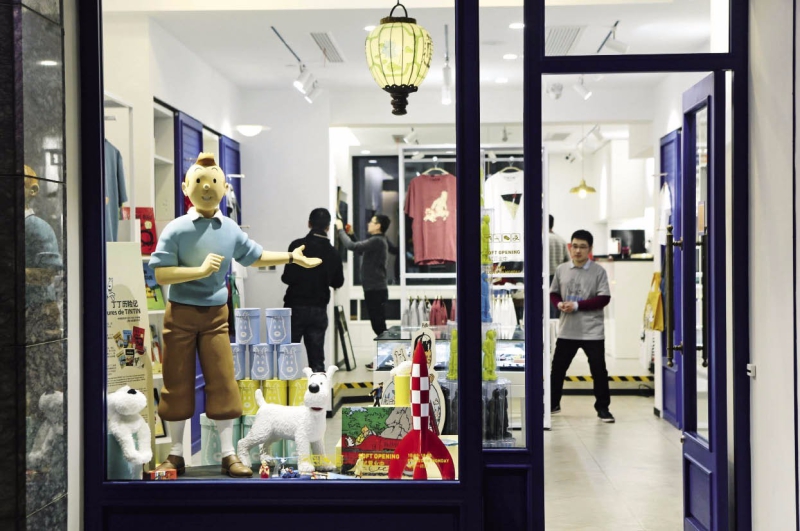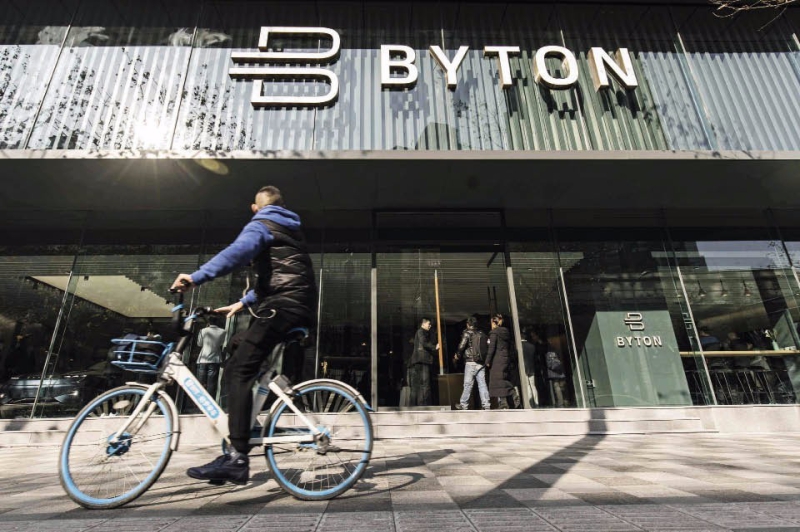The first official Tintin Shop in China has opened in Shanghai.
First Choice to Purchase New Products
A smart terminal emanating a futuristic ambiance has attracted many visitors to the large exhibition hall at No. 762 Nanjing West Road, Shanghai. Covering an area of 700 square meters, this is the world’s first offline experience store of Byton Place, which features its first smart connected car.
Interestingly enough, this store is not alone, for other emerging automobile manufacturers have also set up their first experience stores nearby, including Tesla and NIO.
“To introduce experience stores in mature business districts, what we care about is bringing consumers high-quality and good-taste goods and experience, with the goal to become the leader in this trend of development,” said Wang Yan, deputy director of the Jing’an District Commercial Committee.
It is worth mentioning that among the three NIO stores in Shanghai, the sales volume of its first store in Jing’an District has always taken the lead. “This shows that our commercial district is not only a good display platform, but also a place with an active consumer market,” Wang said, then further exemplified that Starbucks also opened its first overseas Reserve Roastery on Nanjing West Road in Shanghai in 2017 and has received millions of consumers. Today, that shop has become the highest-selling store of Starbucks worldwide.
The so-called “first store” refers to the first store opened in a certain area of a certain representative brand or new fashion brand in the industry. Data shows that in 2018, the total retail sales of consumer goods in Shanghai exceeded RMB 1 trillion, and 55.3 percent of global retailers had presence in the city, making it second only to Dubai in the world. Among them, 835 were newly established stores, including the first stores of more than 300 international brands.

The first official Tintin Shop in China has opened in Shanghai.
In Jing’an District, it is common to see some eye-catching and fascinating store opening up its doors for the first time in the area. After named a Global New Products Release Demonstration Zone in Shanghai in 2018, the district introduced 46 first stores in the first half of 2019, including Celine, Pronovias, and Aldi. Besides, new models of business such as unmanned retail, pop-up shops, new retail shops, and personal customization stores are also emerging.
The district has always adhered to the principles of internationalization, high quality, and innovation. Meanwhile, it also pays great attention to the compatibility between a brand and the location. Only in this way can it enhance the attraction of a shopping mall and better meet the needs of consumers.
Behind the prevalence of the “first store economy” is the profound historical accumulation of Shanghai’s business. In fact, since China’s reform and opening-up began, Shanghai has always been the starting point of the country’s “first store economy.”
In 1989, KFC opened its first store in Shanghai. In 1992, China’s first Sino-foreign joint venture retailer the Yaohan Mall settled in the city. In 1993, Yum’s China headquarters moved from Hong Kong to Shanghai, driving the transformation of China’s fast food industry. In 1995, Carrefour supermarket opened up its first Chinese store in Shanghai, and within a few years, many other foreign companies such as Metro, Lotus, and Auchan began to set up their company headquarters in Shanghai as well. In 1996, the city introduced Japan’s Lawson convenience store, setting a benchmark for convenience stores across the country.
The booming “first store economy” in Shanghai also came about as the result of some policy breakthroughs, such as the establishment of a key trademark protection directory system. In addition to this, some business model innovations have made progress, for example, some perfume brands implement customized after-sales services, and some convenience stores provide hot meals.
The prosperous “first store economy” meets the growing needs of the people for a better life, and will also be a powerful driving force for the high-quality development of Shanghai’s commerce.
Cultural Nightlife
In Da Tong Mill, lively music and laughter incessantly lingers on. Many foreigners living in Shanghai come here to enjoy world cuisines as well as experience Shanghai’s night market.
Amongst these is Hooked, a casual restaurant specializing in fish and chips, seafood poke bowls, and craft beer. According to the restaurant manager, 90 percent of the customers are foreigners and the staff come from all over the world. The owner comes from Australia, shop manager is from the U.K., and the employees come from China, the Philippines, Germany, and the list goes on.
The Shanghai Museum, 1.5 kilometers east of Da Tong Mill, staged a wonderful museum night for a few months. Busy office workers took their children and enjoyed the exotic cultural relics from Oceania and classical Jingdezhen ceramics of the 15th century.
Local residents living in the surrounding area 6.5 kilometers north of the museum can also enjoy a romantic French-style chanson while walking around in the Daning International Commercial Plaza.
When office workers in the skyscrapers pour out of office buildings, when the young people in residential areas invite friends to get together, the night runners complete their nightly tasks... Shanghai is lightened by the evening economy.
The evening economy is not equal to simply killing time in a bar or eating delicious food, it can also integrate with the enjoyment of culture and art. The World Music Shanghai Festival has been held for seven consecutive years, and the Shanghai Xintiandi Christmas Celebration also takes place at the appointed time.
Through blending culture and night life together, the evening economy is being further brought to a higher level. The Shanghai municipal government this year issued the Guiding Opinions on Promoting Evening Economic Development in Shanghai, which specifically pointed out that the city will create a group of landmark nightlife gathering areas and introduce night cultural and artistic projects such as immersive dramas, musicals, and dance dramas. The city will adopt an inclusive and prudent attitude towards nighttime entertainment, such as late night cinema, late night bookstores, and music clubs, and actively develop diversified urban night tours such as Pujiang night tour and museum night tours.
Nightlife in Shanghai makes it a city without darkness. The evening economy is making Shanghai more open and competitive.
A New Mall Experience
In Shanghai, new products, new services and new business models are always the most accepted, and new demands are always the most easily stimulated. During the first half of this year, 498 companies opened their first stores in Shanghai, accounting for half of the national total. Besides, the city’s online transactions increased by 29.8 percent.
In the first half of the year, 25 first-stores were opened in Hongkou District alone. Fengxian District introduced Costco to create a global boutique experience store based on domestic and international first-line cosmetics and health food. Under the promotion of new retail enterprises such as Fresh Hema, the online retail sales in the Pudong New Area increased by 89 percent.
For a long time, there has been a consensus in the retail industry: with the advent of e-commerce platforms, consumers prefer to shop online rather than going to stores. The store business is declining, and the virtual economy affects the real economy. However, the rise of online shopping in Shanghai has awakened traditional shopping malls, and malls began to consider different means of attracting people to shop in them.

A cyclist is passing by the BYTON Place showroom in Shanghai.
During the 40 years of reform and opening-up, China’s economy has developed rapidly. When the generation that grew up during the urbanization process became the main force of consumption, the psychological satisfaction and spiritual enjoyment they once pursued has now shifted from simple shopping to other fields such as tourism, sports, entertainment, and leisure. In this context, the purpose of young consumers for going to shopping malls is gradually shifting from a single-dimension shopping consumption experience to a more comprehensive experience.
How can shops attract people to consume in malls? The experience of Shanghai is the combination of business, tourism, and entertainment. Before the opening of the 2019 Shanghai Shopping Festival, a running game was held in Jing’an District. Over 200 local families ran by scenic spots and cultural landmarks in the district in order to bring popularity and stimulate consumption.
“Through the form of competition, citizens have rediscovered the key shopping malls in our district, which stimulated the participants’ shopping desires and increased visits to the shopping malls. Moreover, the participating families not only improved their parent-child relationships through the competition, but also learned the right concept of consumption and cultivated it within their children at an early age,” said Lu Jun, head of the Commerce and Trade Management Division of the Jing’an District Commercial Committee. According to him, through a series of integrated projects, fresh vitality has been continuously injected into the area, increasing the influence and appeal of the business district.
In addition, a series of culture and art integration activities by luxury brands such as Prada, Gucci and LV not only enhanced the artistic atmosphere of the entire business circle, but also shaped its international image and enhanced consumption.